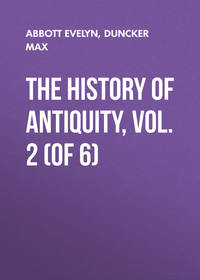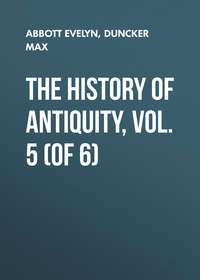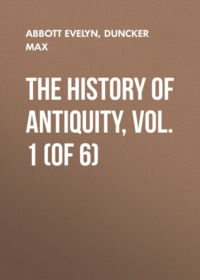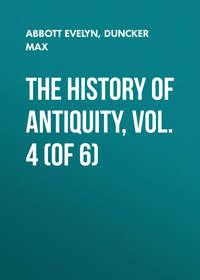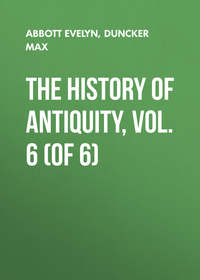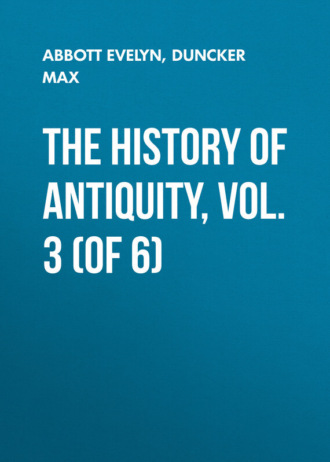 полная версия
полная версияThe History of Antiquity, Vol. 3 (of 6)
143
Brugsch, loc. cit. II. p. 198.
144
Sera en mashush.
145
Chabas, "Mélanges," Ser. 2, pp. 73-107.
146
Lepsius, "Abh. Berl. Akad. Phil. Hist. Klasse," 1856, s. 264. Mariette, "Bull. Archéolog. Athen. Franc." 1855, pp. 93, 98-100.
147
Cp. Von Gutschmid, "Beiträge zur Geschichte des alten Orients," s. 104, seqq.
148
Diod. 1, 45.
149
Plut. "de Isid." c. 8; cf. Athenæus, p. 418.
150
Joseph. "c. Apionem," 2, 2, 6.
151
Mariette, "Revue Archéolog." 1865, 12, 178.
152
Pianchi is also called the son of the high priest Herhor (p. 51). But this coincidence does not compel us to explain the kings of Napata as descendants of that Herhor who lived 400 years before Pianchi of Napata.
153
De Rougé, "Mémoire sur une inscript. de Piankhi;" Brugsch, "Hist. of Egypt," I. 129; II. 243, 247.
154
I have shown above that Petubastis came to the throne about the year 775 B.C., and Bocchoris, the son of Tnephachtus, about 753 B.C.; Tnephachtus, therefore, must be placed in the time between 770-753 B.C. Thus the time of the campaign of Pianchi is fixed. To throw back the campaign nearly 100 years is not possible, owing to the mention of Osorkon, the names of Nemrut, Ssheshonk, Petise, which belong to the house of the Bubastites, and the date of Tnephachtus. If the lists of Assurbanipal mention a Ssheshonk of Busiris, a Tafnecht – not of Sais, but of Buni or Bunubu; a Pefabast, not of Chnensu but of Zoan – the reappearance of these names can be explained by the fact that these dynastic families have also been preserved among the Ethiopians (p. 72).
155
Athenæus, p. 418; Diod. 1, 74.
156
Diod. 1, 94.
157
Diod. 1, 79.
158
Plut. "Demetr." c. 27.
159
Ælian. "Hist. An." 12, 3.
160
Diod. 1, 94.
161
Mariette, "Bab. Athen. Franc." p. 58-62.
162
Ælian. "Hist. An." 11, 11.
163
Ælian. loc. cit. 12, 3.
164
De Rougé, "Mélanges d'Archéol." 1, 37, concludes from the monuments of Tirhaka and the statue of Ameniritis, that Kashta succeeded Pianchi, that Sabakon and the others are children of Kashta (?) According to Brugsch the – ka in Shabaka and Shabataka is the attached article of the Barabra language. Hence it is explained how Saba(ka) can become Seveh among the Hebrews, or Sabhi among the Assyrians. Cf. Oppert. "Mémoire sur les rapports de l'Egypte et de l'Assyrie," p. 12-14.
165
Herod. 2, 137-141.
166
Diod. 1, 45, 65.
167
I have already been able to fix the end of the Ramessids, the date of the Tanites and Bubastites, by the date of the accession of Shishak in the Hebrew reckoning; the length of the dynasty of the Tanites in Manetho; and the length of the Bubastites as corrected by the monuments, and the synchronism of the first Olympiad for Petubastis. For the period from the end of the Bubastites to the accession of Sabakon, the important points are the seventh Olympiad for Bocchoris, and the sarcophagus of the Apis of Bokenranef. If Bocchoris came to the throne in the year 753 B.C., Ssheshonk IV. died in the year 780 B.C.; if this was the thirty-seventh or thirty-eighth of his reign, the successor of the Apis buried in the thirty-seventh year of Ssheshonk might certainly live to the year 748, the sixth year of Bocchoris according to my reckoning. It is decisive for Sabakon's accession in Egypt that Hoshea of Israel undoubtedly ascended the throne in 734 B.C. (p. 16, note; 48). Shalmanesar IV. of Assyria marched against Israel in the year 726 B.C., when he had discovered the conspiracy of Hoshea with Seveh (Sabakon, p. 69). Hoshea must, therefore, have negotiated with Seveh in 727 B.C. at the latest, and probably earlier. Sabakon must have been previously established on the throne of Egypt. He cannot, therefore, have conquered Egypt later than 730 B.C. Bocchoris therefore reigned 23 years (753-730 B.C.); the time which Manetho allots to Bocchoris, six years, is too short for the completion of his legislation and the attainment of that fame as a legislator which he left behind him, according to the account of the Greeks. That Tirhaka reigned over Meroe and Egypt in the year 702 at the latest, is proved by the battle of Eltekeh, which was fought in 701 B.C. (p. 125). If Seveh, who negotiated with Hoshea, is supposed to be Sabataka, the conquest of Egypt by Sabakon must be put in the year 739. The Apis discovered in the twenty-sixth year of Tirhaka and buried in the twentieth year of Psammetichus, shows that according to the chronology of that period, Psammetichus was regarded as the immediate successor of Tirhaka. According to the reign of 54 years allotted to him by Herodotus and Manetho, Psammetichus begins in 664 B.C., since his death is fixed with certainty in 610 B.C. If Tirhaka's reign over Egypt began in the year 703 B.C., the year 678 would be the twenty-sixth of his reign; the Apis lived down to the twentieth year of the reign of Psammetichus, i. e. down to the year 645 B.C. – consequently 30 years, an age (the number on the inscription is illegible), which even a less carefully tended bull might attain. Tirhaka reigned from 703 to 664 B.C., i. e. 39 years. If the lists of Manetho, according to our excerpts, allow him only 18 years (Syncellus gives 20), this is obviously due to the fact that the reigns of Stephinates, Nechepsus, and Necho, who ought to stand side by side with Tirhaka, with seven, six, and eight years, i. e. with 21 years in all, are deducted from the reign of Tirhaka, in order to place these three princes after him. To the predecessors of Tirhaka, Sabakon and Sebichus, Manetho allows eight and fourteen years. The monuments of Egypt show that Sabakon reigned at least 12 years; Sabakon must, therefore, according to these dates, have begun to reign in Egypt not later than 729 B.C. (664 + 39 + 26). The Assyrian monuments show that Sabakon fought with Sargon at Raphia in the year 720 B.C., and his successor negotiated with him; that Tirhaka fought with Sennacherib in Syria in 701 B.C., and that he was at war with Assurbanipal about the year 666 B.C.
168
Goodwin in Chabas, "Mélanges," 1, 249 ff.
169
Among the Hebrews, the king with whom Hoshea of Israel (734-722 B.C.), negotiates is called Seveh (So). Sargon's inscriptions name the opponent against whom he fought at Raphia in the year 720 B.C. "Sabhi, Sar of the land of Muzur," and also "Sabhi Siltannu of Muzur." The inscription of Karnak gives Sabakon's (Shabaka's) twelfth year; we must, therefore, although Manetho's list allows him only eight years, assume that Sabakon was the opponent of Sargon at Raphia, as stated in a preceding note. If Sabakon died immediately after his twelfth year, he died in 717 B.C. The ruler of Egypt who pays tribute to Sargon in the year 716, is repeatedly called by the Assyrian inscriptions, "Pirhu (Pharaoh), Sar of Muzur." So in the cylinder of G. Smith ("Disc." p. 295), the ruler of Egypt, who unites with Ashdod in the year 711 B.C., is called "Pirhu Sar of Muzur;" finally, the prince who delivers up Yaman, when it has been mentioned that Yaman fled beyond Egypt into the border land of Miluhhi, is called by Sargon "Sar Miluhhi." The Pharaoh, Sar Muzur, whom we find on the throne of Egypt in 716 to 711 B.C., and the Sar Miluhhi, who gives up Yaman, can only be Shabataka-Sebichus, the successor of Sabakon.
170
Mariette, "Monuments," pl. 29 e.
171
Not much weight could be laid on the observation in the Palatine codex of Hieronymus (Jerome); Tarachus (ab Æthiopia duxit exercitum), Sebico interfecto Ægyptiis regnavit annis xx.; but in the inscription of Medinet Habu Tirhaka calls himself conqueror of Kemi, i. e. of Egypt.
172
Lepsius, "Briefe," s. 239, 275.
173
Brugsch, "Geogr." 1, 163.
174
Strabo, p. 61, 686, 687. Büdinger's view ("Ægypt. Forschung. Herodots," 2, 32), that we must recognise Tirhaka in the Etearchus of Herodotus might be adopted if the narrative did not too definitely point out travelling Cyrenæans as the source; and the founding of Cyrene cannot be carried back to the time of Tirhaka.
175
2 Kings xvi. 10-18.
176
No one can seriously maintain that Ahaz imitated the ritual of the chief enemy of Assyria and Judah, the altar and worship of Rezin, who was moreover now overthrown.
177
Isa. i. 3, 5-9; ii. 6.
178
The Books of Kings are only wrong in representing Hoshea as first subject, and paying tribute, to Shalmanesar IV. (xvii. 3).
179
2 Kings xvii. 4.
180
Isa. xiv. 29-31.
181
Isa. xxiii. 1-12.
182
Isa. xxviii. 1-6.
183
So must we read for 800; 60 penteconters required 3000; 60 triremes at least 8000 rowers.
184
"Antiq." 9, 14, 2.
185
As Samaria was besieged 724-722 B.C., we may place the beginning of the Assyrian war in 726.
186
Oppert, "Dour Sarkayan," p. 8, 30; "Records of the Past," 7, 28; E. Schrader, "K. A. T." s. 160; Ménant, "Annal." p. 161.
187
E. Schrader, loc. cit. s. 158; Ménant, "Annal." p. 181.
188
L. 26, in Ménant, loc. cit. p. 192.
189
L. 17, in Ménant, p. 200.
190
2 Kings xvii. 6, 24.
191
"The Annals of Sargon," Oppert, "Records of the Past," 7, 29.
192
Oppert, loc. cit. 7, 30.
193
G. Smith, "Assyr. Canon," p. 125, 126.
194
Isa. xi. 6-8; 2 Chron. xxx. 6, 10; xxxiv. 9.
195
2 Kings xvii. 26 ff.
196
Inscription of Nimrud, in Ménant, loc. cit. p. 205; in E. Schrader, loc. cit. p. 90.
197
"Annals of Sargon," Oppert, "Records of the Past," 7, 29; G. Smith, loc. cit.
198
In the great hall No. 8, in Botta. Ménant, p. 182.
199
Memorial-stone of Larnaka, in Ménant, p. 207; G. Smith, "Assyr. Canon," p. 127.
200
Oppert, "Records of the Past," 7, 29; E. Schrader, "K. A. T." 258; Ménant, loc. cit. p. 161.
201
Ménant, loc. cit. p. 159, 192.
202
E. Schrader, loc. cit. s. 258.
203
Oppert, "Records of the Past," 7, 34.
204
Communication from E. Schrader.
205
E. Schrader, "K. A. T." s. 258; Ménant, loc. cit. p. 181.
206
Isa. xx. 1 ff.
207
Oppert, loc. cit. 7, 40; Ménant, p. 169; cf. l. 12 of the inscription on the bulls in Ménant, p. 162.
208
G. Smith's Cylinder, "Disc." p. 289 ff.
209
Ménant, p. 159.
210
Oppert, "Records of the Past," 7, 26.
211
E. Schrader, "K. A. T." s. 257 ff.; cf. Ménant, loc. cit. p. 186.
212
Ménant, loc. cit. p. 159.
213
Ménant, p. 189, 206-208. That the stone cannot have been set up in Babylon before the payment of tribute in 709B.C., is proved by the mention of the tribute upon it. Cp. G. Smith, "Z. Ægypt. Sprache," 1869, s. 109; 1870, s. 70, 71.
214
Flandin gives the long and short sides of the rectangle doubled at 6784 metres; the inscription which reckons in the whole circuit the building of the palace which juts out from the rest, at 16,280 cubits (ammat). The Babylonian and Assyrian cubits are both = 525 millimetres; Lepsius, "Abh. Berl. Akad." 1853; "Monats-Berichte Ders." 1877. Vol. I. p. 305.
215
Rawlinson, "Monarch," 12, 324 ff.
216
Oppert, "Dour Sarkayan," p. 23, 24.
217
Oppert, "Records of the Past," 7, 55, 56.
218
Oppert, "Dour Sarkayan," p. 8.
219
In Ménant, loc. cit. p. 181.
220
Oppert, "Dour Sarkayan," p. 27, 28; Oppert et Ménant, "Doc. juridiques," p. 168.
221
Ménant, "Annal." 162. In Oppert, "Records of the Past," 7, 30, the fourth canton is called Pappa. Above, p. 86.
222
Inscription of Nimrud in Ménant, loc. cit. p. 206. He reads two talents 30 minæ of gold; G. Smith reads 11 talents of gold.
223
Oppert, "Records of the Past," 7, 32.
224
Oppert, "Records of the Past," 7, 35, 36, 37. Vol I., p. 520.
225
Annals in Ménant, loc. cit. p. 164.
226
Annals in Ménant, p. 164; Oppert, loc. cit. 7, 33.
227
Ménant p. 183.
228
Oppert, loc cit. 7, 34.
229
Ménant, p. 184.
230
Ménant p. 167; Oppert, loc. cit. 7, 37.
231
G. Smith, "Disc." p. 289.
232
Oppert, loc. cit. 7, 27; Ménant, loc. cit. p. 192, 195, 200, 201, 205, 207.
233
In Ménant, loc. cit. p. 188.
234
Above, p. 93; Oppert, "Records of the Past," 7, 46-51.
235
Ménant, "Babylone," p. 157.
236
The Annals in Oppert, loc. cit. 7, 51-53. The Fasti in Ménant, "Annal." p. 186, 187.
237
Cylinder Bellino in Ménant, "Annal." p. 229.
238
G. Rawlinson, "Monarch," 22. 179, n. 5.
239
Ménant, loc. cit. 229, 230.
240
Ménant, loc. cit. p. 212.
241
Ménant, loc. cit. p. 228, 229.
242
Ménant, loc. cit. p. 211.
243
Year of Nabudurussur.
244
G. Smith, "Disc." p. 308.
245
G. Smith, "Assurbanipal," p. 318.
246
Ménant, loc. cit. p. 224.
247
Rodwell, "Records of the Past," 9, 23; Ménant, loc. cit. p. 235.
248
In Ménant, loc. cit. p. 237.
249
Joseph. "Antiq." 10, 1, 4.
250
In Euseb. "Chron." 1, p. 35, ed. Schöne.
251
Euseb. "Chron." 1, p. 27, ed. Schöne.
252
Cf. E. Schrader, "K. A. T." s. 213 ff.
253
In Ménant, "Annal." p. 231.
254
E. Schrader, "K. A. T." s. 219 ff.
255
G. Smith, "Disc." p. 298; Cylinder Taylor in Ménant, "Annal." p. 215.
256
G. Smith's Cylinder, "Disc." p. 298; Ménant reads 2800 prisoners on the Cylinder Taylor.
257
Cylinder Bellino.
258
Cylinder Bellino, in Ménant, p. 228; Cylinder G. Smith, "Disc." p. 302; Cylinder Taylor in Ménant, p. 227; "Records of the Past," 7, 61.
259
G. Smith, "Disc." p. 308; Ménant, "Annal." p. 219, "Records of the Past," 7, 63.
260
The fourth campaign of Sennacherib, the establishment of Assurnadin cannot be later than the year 698 B.C., since the Cylinder Smith, which dates from the year 697 B.C., concludes with these events, and then speaks only of the buildings; G. Smith, "Disc." p. 308.
261
In Ménant, loc. cit. p. 220, 221.
262
In Ménant, p. 232.
263
An inscription of this king found at Susa is explained by Oppert, "Records of the Past," 7, 82.
264
In Ménant, loc. cit. p. 232.
265
Above, p. 114; Annals of Sargon, in Oppert, "Records of the Past," 7, 45.
266
Cylinder Taylor in Ménant, p. 222.
267
Cylinder Taylor in Ménant, p. 232, 233; Talbot, "Records of the Past," 1, 78.
268
Inscription of Nebbi Yunus in Ménant, loc. cit. p. 232. An inscription of Exarhaddon repeats the events of this war: Suzub, "of unknown race, a lower chieftain," came to Babylon, and was raised to be king; Umman Minanu was gained by the treasures of Bit Saggatu; the Parsua joined, etc.; G. Smith, "Disc." p. 315.
269
Rodwell, "Records of the Past," 9, 27, 28; Ménant, "Babylone," p. 166. Vol. II. p. 40.
270
2 Kings xx. 12.
271
Merodach Baladan was, as has been shown (p. 113), driven out of Babylon in the year 703 B.C.; it is certain that he was ruler there in 704 B.C. If the Books of the Kings do not mention his embassy to Hezekiah till after the siege of Jerusalem by the Assyrians, they show by the announcement of Isaiah to Hezekiah, which they put after the embassy of Merodach Baladan thus: "He will be saved out of the hand of the Assyrians" (2, xx. 6), that the embassy was at Jerusalem before the campaign of Sennacherib; cf. Isa. xxxix.
272
Isa. xxii. 2; 2 Chron. xxxii. 4, 5.
273
Isa. xxx. 2, 3, 6.
274
Isa. xxxi. 1-3.
275
Isa. xxx. 9, 10.
276
Isa. xxviii. 12.
277
Isa. xxviii. 15. The deceit is no doubt to be explained by the secrecy of the negotiations with Egypt.
278
Isa. xxx. 15, 16.
279
Isa. xxx. 12, 13.
280
Isa. xxviii. 22.
281
Isa. xxix. 1.
282
Isa. x. 28-32.
283
Isa. xxi. 1, 2, 5-7.
284
It is the third warlike enterprise of Sennacherib, which for the following reasons cannot be placed earlier than 702 B.C. The cylinder Bellino dates from the seventh month of the third year of Sennacherib, i. e. from the year 703 / 702; it concludes with the subjugation of Ellip and the tribute of the Medes. Sennacherib, therefore, may have first marched to Syria in the year 701 B.C. The inscription of the bulls narrates this campaign, which extends to the establishment of Assurnadin in Babylon; so the cylinder Smith, which dates from the year 697 B.C. Hence, as the year of Hezekiah's accession is fixed for the year 728 B.C. (p. 16, n.), the siege of Jerusalem does not fall in the fourteenth year of Hezekiah, in which the Books of Kings place it, but in the twenty-eighth year.
285
I combine these three accounts, which differ but little from each other.
286
Cylinder Smith, "Disc." p. 304.
287
G. Smith, "Disc." p. 304.
288
Inscription of the bulls in E. Schrader, "K. A. T." l. 31, s. 187.
289
E. Schrader, "K. A. T." 171 ff. G. Smith, "Disc." p. 303 ff. Rodwell, "Records of the Past," 7, 61 ff.
290
Isa. xxii. 9, 10, 11.
291
2 Kings xviii. 13 ff.; 2 Kings xix. 8-13; Isa. xxxvi., xxxvii.; 2 Chron. xxxii.
292
Brandis, "Münzwesen," s. 98.
293
Room 36, in Layard.
294
E. Schrader, "K. A. T." s. 170.
295
Isa. i. 25.
296
Isa. xxx. 19.
297
Isa. ii. 12-22.
298
Isa. xix. 22.
299
Isa. xix. 25.
300
Isa. ii. 3, 4.
301
Isa. xi. 6-8; cf. xxv. 6-12; xxxv. 5-10. The ideas of the happy future are not quite consistent in Isaiah. If in one place he extends the peace of the world down to the beasts of prey, in others he represents the restored kingdom of David, the united Ephraim and Judah, as "oppressing their oppressors." "Judah will be a terror for Egypt" (xix. 17), and the Israelites will "flee to the sea on the shoulders of the Philistines: together they will plunder the sons of the East, and subjugate Edom, Moab, and Ammon" (xi. 14). In the same way the new king of the race of David, who will then rule, appears to him at one time gifted with the strength of David, and is again described as participating in the Divine nature, and passes into a general picture of the happy future.
302
Isa. xxvii. 8.
303
Isa. x. 5, 6.
304
Isa. x. 7-18.
305
Isa. xxxiii. 1.
306
Isa. x. 24-27.
307
2 Kings xix. 25-33; Isa. xxxvi., xxxvii. 1-34.
308
Isa. xiv. 24-27.
309
Isa. xvii. 12-14.
310
In Ménant, "Annal." p. 231.
311
2 Kings xix. 35, 36.
312
2 Kings xviii. 4.
313
Herod. 2, 141.
314
G. Smith, "Assyr. Canon," p. 139. The fragment must speak of events subsequent to the year 691B.C., since the cylinder Taylor, which dates from this year, does not mention this war.
315
Above, p. 11.
316
E. Schrader, "K. A. T.," s. 227.
317
G. Smith, "Assurbanipal," p. 207, 247. Ménant, "Annal." p. 291.


